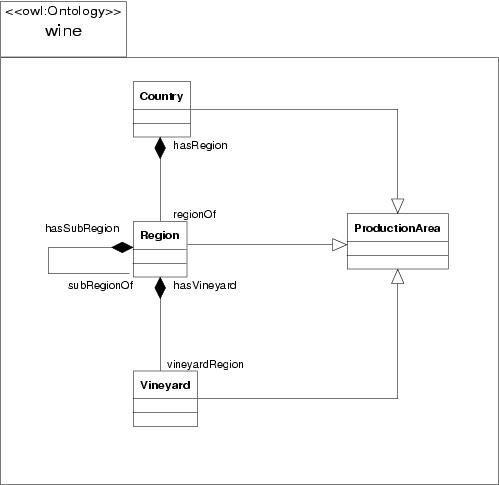- From: Guus Schreiber <schreiber@swi.psy.uva.nl>
- Date: Fri, 23 Aug 2002 14:09:43 +0200
- To: WebOnt WG <www-webont-wg@w3.org>
- Message-ID: <3D662607.8080007@swi.psy.uva.nl>
ACTION: Guus to put together an example from his wine stuff - small part of ontology that contains this kind of region/PartOf example - for walkthru document I have put togehter a small example. It probably needs some more explamatory text. I'm also not sure whther this should go into the walkthru, or whether it should go into the "how-to-do-it" doc. I consider this also as input for Larry's request for part-whole examples. Guus -- A. Th. Schreiber, SWI, University of Amsterdam, http://www.swi.psy.uva.nl/usr/Schreiber/home.html
For wine the "production area" is an important feature. There is
enormous variation between wine types w.r.t. the grain size of the
production area, ranging from a complete country to a particular vineyard.
One could distinguish four types of production area's:
1. country: e.g., France, Italy
2. region: e.g., Bordeaux, Medoc, Tuscany,
3. town: e.g., Margaux, Montalcino, Montepulciano
4. vineyard, e.g., Chateau Margaux, Avignonesi
In addition, we need to model part-of relationships between the
various sorts of production areas:
- regions are part of countries: Tuscany lies in Italy
- regions may have subregions: the Medoc region is a subpart of the
Bordeaux region
- towns are located in regions: Montalcino is located in Tuscany
- vineyards are located in towns: Chateau Margaux us a vineyard in
Margaux, Avignonesi in Montepulciano
We would like to be able to derive from our wine KB that a wine from
Chateau Margaux is a French wine and that Avignonesi is a Tuscan
wine.
MODELLING DECISION: at this point we decided to drop the "town"
subclass and treat towns as regions. This simplifies the model and is
consistent with the fact that a "town" as a wine production area
typically stands for an area surrounding the town, which can be larger
or smaller that the actual town area. For example, the production
area "Montalcino" is in fact a subregion of Tuscany surrounding the
village of Montalcino.
This leads to the following model:
Classes:
wine:ProductionArea rdf:type rdfs:Class.
wine:Country rdfs:SubClassOf wine;ProductionArea.
wine:Region rdfs:SubClassOf wine;ProductionArea.
wine:Vineyard rdfs:SubClassOf wine;ProductionArea.
Properties:
wine:hasSubArea rdf:type rdfs:Property.
wine:hasSubArea rdf:type owl:TransitiveProperty.
wine:subAreaOf owl:inverseOf wine:hasSubArea.
wine:hasRegion rdfs:SubPropertyOf wine:hasSubArea.
wine:hasRegion owl:allValuesFrom wine:Region.
wine:regionOf owl:inverseOf wine:hasRegion.
wine:regionOf owl:allValuesFrom wine:Country.
wine:regionOf owl:cardinality 1.
wine:hasSubRegion rdfs:SubPropertyOf wine:hasSubArea.
wine:hasSubRegion owl:allValuesFrom wine:Region.
wine:subRegionOf owl:inverseOf wine:hasSubRegion.
wine:subRegionOf owl:allValuesFrom wine:Region.
wine:subRegionOf owl:cardinality 1.
wine:hasVineyard rdfs:SubPropertyOf wine:hasSubArea.
wine:hasVineyard owl:allValuesFrom wine:Vineyard.
wine:vineyardRegion owl:inverseOf wine:hasVineyard..
wine:vineyardRegion owl:allValuesFrom wine:Region.
wine:vineyardRegion owl:cardinality 1.
ONTOLOGICAL NOTE: the part-whole relationship described here is
well-known in the formal-ontology literature. The typology of
part-whole relations by Winston et al. [1] characterize this as a
"place-area" relation. Various authors have critised and amended this
typology. If the formal-ontology community would, at some point, be
able to make a part-whole typology available in OWL, the properties in
this wine ontology could be linked to it.
UML NOTE:
Encl. is a UML class diagram for this example. The modelling decisions
for this diagram will be discussed in the forthcoming document on the
UML presentation syntax. For the moment, note the use of the UML
"composition" construct (the darkened diamond), which caries some of
the semantics of the please-area relation.
[1] Winston, Chaffin & Herrmann. A Taxonomy of Part-Whole
Relations. Cognitive Science, 11:417-444, 1987.
Attachments
- image/jpeg attachment: owl-production-area.jpg

Received on Friday, 23 August 2002 08:33:05 UTC